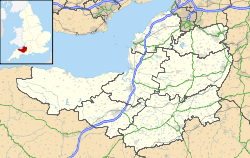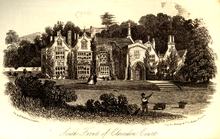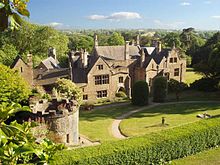- Clevedon Court
-
Clevedon Court 
General information Town or city Clevedon Country England Coordinates 51°26′27″N 2°50′01″W / 51.4407°N 2.8335°WCoordinates: 51°26′27″N 2°50′01″W / 51.4407°N 2.8335°W Completed 14th century Design and construction Client Sir John de Clevedon Clevedon Court is a manor house on Court Hill in Clevedon, North Somerset, England, dating from the early fourteenth century. It is now owned by the National Trust. It has been designated by English Heritage as a Grade I listed building.[1]
Contents
History
Much of the present house was built in the early 14th century. There is speculation, that it may lie on the site of a Roman building, but the evidence, based on excavations 50 metres (160 ft) to the South of the house in 1961/62 is now known to be uncertain. .[2] The house incorporates remnants of a 13th century building which lie at an angle to the rest of the house. It was situated a couple of miles inland from the parish church of St Andrew and the village of Clevedon, which was then a small collection of cottages. The builder was Sir John de Clevedon, a descendant of the Norman Ildebert who was given the manor of Clevedon after the Norman Conquest. Perhaps because of the distance to the parish church, the manor house included a chapel dedicated to St Peter. The house has undergone considerable change since it was built, almost every century seeing structural alterations, but it still largely retains the features of a mediaeval manor.[3]
The de Clevedon family line ended in 1376, and the manor eventually passed, by marriage, to the Northamptonshire family of Wake, who were Lords of the manor until 1630. John Wake made major additions to the house in the late 16th century, including a new west wing. The manor was sold by Sir Baldwin Wake to Sir John Digby in 1630. Digby's estates were confiscated during the English Civil War, but were recovered after the Restoration by his heir. In 1709 the house was bought by Abraham Elton, a merchant from Bristol.[4]
The Eltons were a prominent Bristol family, and Abraham had been a member of the Society of Merchant Venturers and Sheriff of Bristol. In later years he was Mayor of Bristol, High Sheriff of Gloucestershire, and Member of Parliament for the five years preceding his death in 1727. He was created a Baronet in 1717 (see Elton Baronets). The family wealth originally came from copper and brass (including mining in the Mendip Hills and other commerce, and property. His descendants, not only at Clevedon, also profited from the slave trade.[5]
Sir Abraham Elton was succeeded by four further Sir Abraham Eltons. Sir Abraham Elton, 2nd Baronet, and his son Sir Abraham Elton, 3rd Baronet, were also Sheriff and Mayor of Bristol in their time, and the second Baronet was also MP for Taunton and subsequently Bristol. The third Baronet died bankrupt, and the estate (which had been entailed to protect it from his creditors) passed in 1761 to his brother, Sir Abraham Isaac Elton, 4th Baronet. He made substantial changes to the house and grounds in the then fashionable Gothic revival style, and was succeeded in 1790 by his son, Sir Abraham Elton, 5th Baronet. He was ordained as a young man, and was a curate in West Bromwich before inheriting the title. He was a supporter of Hannah More, and a fervent opponent of Methodism, at one time inducing the vicar of Blagdon to sack his curate, causing national scandal. His second wife Mary made further alterations to the house in the early 19th century, and also made many improvements to the town, including a school. One of the town's modern primary schools is named after her.[6]
The line of Abrahams came to an end in 1842 when Sir Charles Abraham Elton, 6th Baronet, succeeded his father. Sir Charles was a writer, and contributed to several periodicals including The Gentleman's Magazine. Sir Charles' sister Julia was married to the historian Henry Hallam, and his nephew Arthur Hallam is buried in the Elton family vault at St Andrew's church. Arthur Hallam is the subject of Alfred Tennyson's In Memoriam, and Tennyson visited Clevedon Court in 1850. William Makepeace Thackeray was a visitor to the court during Sir Charles's time and it was the inspiration for the house Castlewood which featured in his novel The History of Henry Esmond[7] although, contrary to common belief, it is improbable that he wrote any of it at Clevedon Court.[8] Samuel Taylor Coleridge lived in Clevedon briefly during this period and may have visited the Court.[9]
Sir Arthur Elton, 7th Baronet, inherited the house and title in 1853, and like his father was a writer. He resigned as Member of Parliament (MP) for Bath in 1859 due to his opposition to the Crimean War, and spent the rest of his life improving the town, setting up a lending library and allotments, and building and funding the cottage hospital (still in existence). All Saints' Church, near the Court, was built in 1860 on the orders of Sir Arthur, and he also made additions to the fabric of the Court itself. The west wing of the house was largely destroyed by a fire in 1882 and rebuilt, with C. E. Davis as the architect.[1] During these building works, the chapel was rediscovered, the East window having been filled and and altar broken off (perhaps during the English Protestant Reformation), and the room having been known until then as the "Lady's Bower".[10]
Sir Edmund Elton, 8th Baronet, nephew of Sir Arthur, inherited the estate and title in 1883. He was an enthusiastic voluntary fireman, and inventor of one of the first forked bicycle brakes, as well as a device to prevent ladies' skirts from becoming entangled in bicycle wheels. He was also a well-known potter, setting up his "Sunflower Pottery" in the Court grounds with the help of a local boy called George Masters. "Elton ware" became popular, especially in America where it was marketed by Tiffany & Co. Elton and Masters' work typically has a variety of rich colours, bas-relief decoration of flowers in a style similar to Art Nouveau, and in the later works metallic glazes are often used.[11]
Sir Edmund's son Sir Ambrose succeeded him in 1920. His son Sir Arthur was one of the pioneers of documentary film making in the years prior to the Second World War,[12] working with John Grierson. He inherited the title on his father's death in 1951. The house was donated to the National Trust in part-payment of death duties,[13] and the west wing (rebuilt after the fire of 1882) was demolished in 1960. Sir Arthur died in 1973 and was succeeded by Sir Charles. The Elton family is still resident in the house, which is now open to the public.
Architecture
The centre of the present South front belongs to the original house. It has a two-storey buttressed porch with plain parapet. The pointed moulded archway has a portcullis. The medieval hall with part of the original screens passage arrangement (entrances to kitchen, buttery etc.) survives behind the projecting porch. Alterations and additions to Clevedon Court included a new West wing by John Wake about 1570.[1] The West front was rebuilt in 1761-88 and again in 1862[1] The Great Hall window between these blocks is now in Tudor style but actually dates from 1912. Evidence of an earlier pointed arch with tracery exists above. The rest of the south front has gabled ranges in Elizabethan style with stone mullioned and transomed windows. The top storey windows in the gables have pediments containing carved heads, and finials above. To the rear of the East range is attached a four storey tower.[1]
Interior
The inside includes a collection of Eltonware ceramics and Nailsea glass.[14] Eltonware is a brightly coloured pottery developed by Sir Edmund Elton (1846–1920), which was marketed in New York by Tiffany & Co.[9]
Grounds
Surrounding the house there are 18th century terraced gardens and parkland with various buildings.
The barn to the east of the stable block , containing a lot of mediaeval stonework is in fact Georgian. The stables themselves date from the 18th century.[15] The crenellated wall and circular tower running from the north-east corner of the court maybe contemporary with the main part of the surviving mediaeval building but their dates and purposes remain obscure. The rear wall of the terrace garden is probably 18th century,[16] while the octagonal summer house and gazebo date from the later 18th century. The lodge at the South entrance was built in 1851. Early pictures of the court show a building, known as Wake's Tower on Court Hill, which may have been built as a watchtower at the time of the Spanish Armada and was demolished before 1738. A summerhouse was built on the site but this too was in ruins by the early 19th century.[17]
See also
- List of Grade I listed buildings in North Somerset
References
- ^ a b c d e "Clevedon Court". Images of England. http://www.imagesofengland.org.uk/Details/Default.aspx?id=33130. Retrieved 16 March 2008.
- ^ "Annual Archæological Review 2001-2002" (PDF). National Trust. http://www.nationaltrust.org.uk/main/w-ar4_t_wes.pdf. Retrieved 16 March 2008.
- ^ "Annual Archæological Review 2001-2002". National Trust. http://www.nationaltrust.org.uk/main/w-ar4_t_wes.pdf. Retrieved 8 October 2011.
- ^ "The Eltons". Mayors and Sheriffs of Bristol 1700 -1799. http://www.davenapier.pwp.blueyonder.co.uk/mayors/history1.htm. Retrieved 10 September 2011.
- ^ "Clevedon Court". Pastscape National Monument Record. English Heritage. http://www.pastscape.org.uk/hob.aspx?hob_id=195562. Retrieved 9 September 2011.
- ^ "Mary Elton Primary School". North Somerset. http://www.maryelton.n-somerset.sch.uk/. Retrieved 10 September 2011.
- ^ Thackeray, William Makepeace (1991). Hawes, Donald. ed. Henry Esmond (World's Classics). Oxford Paperbacks. ISBN 978-0192827272.
- ^ "Clevedon". Encyclopædia Britannica Eleventh Edition. Volume 6. 1911. pp. 500.
- ^ a b Scott, Shane (1995). The hidden places of Somerset. Aldermaston: Travel Publishing Ltd. p. 37. ISBN 1902007018.
- ^ "Proceedings during the year 1899". Arch&ological & Natural History Society.. http://www.archive.org/stream/proceedings45someuoft/proceedings45someuoft_djvu.txt. Retrieved 8 October 2011.
- ^ "Elton Pinched Rim Jug". Terra Mare Antiques. http://www.terramareantiques.com/viewItem.php?itemid=2160&PHPSESSID=abff45c2644f85971aa1b3eb6797eb22. Retrieved 10 September 2011.
- ^ "Person Page - 39892". Peerage.com. http://thepeerage.com/p39892.htm. Retrieved 10 September 2011.
- ^ "Clevedon Court". TourUK. http://www.touruk.co.uk/houses/Clevedon-Court-North-Somerset.htm. Retrieved 10 September 2011.
- ^ "Clevedon Court". National Trust. http://www.nationaltrust.org.uk/main/w-vh/w-visits/w-findaplace/w-clevedoncourt/. Retrieved 16 March 2008.
- ^ "The stable block to north-east of Clevedon Court". Images of England. http://www.imagesofengland.org.uk/Details/Default.aspx?id=33134. Retrieved 16 March 2008.
- ^ "Rear wall of terrace garden to north of Clevedon Court". Images of England. http://www.imagesofengland.org.uk/Details/Default.aspx?id=33132. Retrieved 16 March 2008.
- ^ Holt, Jonathan (2007). Somerset Follies. Bath: Akeman Press. p. 67. ISBN 9780954613877.
Further reading
- Elton, Julia; Anne Yarrow (2003). Clevedon Court. National Trust. ISBN 1843590875.
Categories:- National Trust properties in Somerset
- Grade I listed buildings in Somerset
- Visitor attractions in North Somerset
- 14th-century architecture
- Historic house museums in Somerset
- Buildings and structures in North Somerset
- Country houses in Somerset
- Clevedon
- Gothic Revival architecture in Somerset
- Grade I listed houses
Wikimedia Foundation. 2010.




